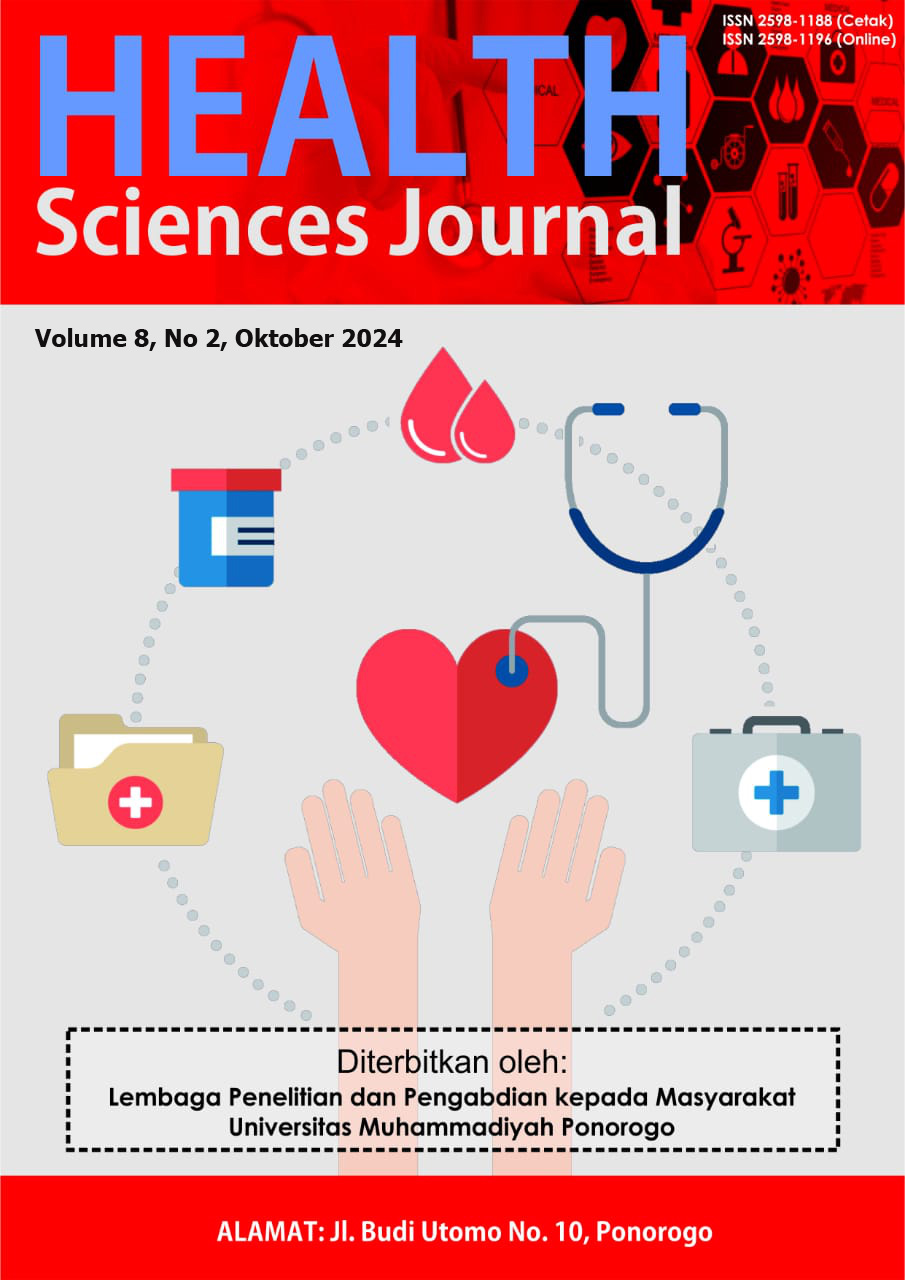PENERAPAN LATIHAN RANGE OF MOTION (ROM) CYLINDRICAL GRIP TERHADAP KEKUATAN OTOT EKSTREMITAS ATAS PADA PENDERITA STROKE NON HEMORAGIK DENGAN MASALAH KEPERAWATAN GANGGUAN MOBILITAS FISIK
DOI:
https://doi.org/10.24269/hsj.v8i2.2693Abstract
Impaired physical mobility is a result of blocked blood vessels due to stroke. Functions lost due to motor disorders in stroke patients result in extremity dysfunction, there by reducing muscle strength. A form of management to restore muscle strength in non-hemorrhagic stroke patients is Range of Motion (ROM) Cyindrical Grip which is useful for improving the ability to move joints normally to increase muscle mass.
Nursing care for Mrs. R with nursing problems with physical mobility disorders is carried out in the KH. Ahmad Dahlan Room RSU Muhammadiyah of Ponorogo for 6 days from 28 July to 02 August 2023. The method used is a case study with a nursing process approach. The results of the assessment showed that the client experienced weakness in the left limb and a history of hypertension. The nursing action taken to overcome the problem is by implementing the ROM Cylindrical Grip exercise. It can be concluded that the ROM Cylindrical Grip can increase the muscle strength of the upper extremities in non-hemorrhagic stroke sufferers. After doing 2 x 10 minutes of exercise for 5 days, the muscle strength of the upper extremities in non-hemorrhagic stroke sufferers increased from 0 to 1. The results of this study, if the ROM Cylindrical Grip was carried out periodically and continuously, resulted in gripping muscle strength in non-hemorrhagic stroke sufferers increase.
Keyword: Impaired Physical Mobility, Muscle Strength, ROM Cylindrical Grip, Non Hemorrhagic Stroke
References
Anggraini, G. D., Septiyanti, S., & Dahrizal, D. (2018). Range Of Motion (ROM) Cylindrical Grip dapat Meningkatkan Kekuatan Otot Ekstremitas Atas Pasien Stroke. Jurnal Ilmu Dan Teknologi Kesehatan, 2(1).
Ariastuti, N. L. (2015). Pengaruh Range Of Motion Aktif (Cylindrical Grip) Terhadap Kekuatan Otot Ekstermitas Atas Pada Pasien Stroke Non Hemoragik DI SMC Rs. Telogorejo. Jurnal Ilmu Keperawatan, 5(1).
Choirunnisya, et.al. (2023). Penerapan ROM Aktif (Cylindrical Grip) Terhadap Peningkatan Kekuatan Otot Ekstremitas Atas Pada Pasien Stroke Non Hemoragik. Jurnal Cendekia Muda, 3(1).
Hidayat, A. (2014). Metode Penelitian Kebidanan dan Teknik Analisa Data. Yogyakarta: Salemba Medika.
Heriana, P. (2014). Buku Ajar Kebutuhan Dasar Manusia. Binarupa Aksara: Jakarta.
Irfan, M. (2012). Fisioterapi Bagi Insan Stroke. Graha Ilmu: Yogyakarta.
Irvan, M. (2020). Penerapan ROM Cylindrical Grip Untuk Meningkatkan Kekuatan Otot Ekstremtas Atas Pada Pasien Stroke. Jurnal PKK Palembang, 2(1).
Riskesdas. (2018). Riset Kesehatan Dasar Tentang Penyakit Tidak Menular - Data Stroke Tertinggi di Indonesia 2018. Kementerian Kesehatan Republik Indonesia.
PPNI, T. P., (2018). Standar Diagnosis Keperawatan Indonesia (SKI). Definisi dan Indikator Diagnostik. Cetakan III edisi 1. Jakarta: DPP PPNI.
PPNI, T. P., (2018). Standar Intervensi Keperawatan Indonesia (SIKI). Definisi dan Tindakan Diagnostik. Cetakan II edisi 1. Jakarta: DPP PPNI.
PPNI, T. P., (2018). Standar Luaran Keperawatan Indonesia (SLKI). Definisi dan Kriteria Hasil Keperawatan. Cetakan II edisi 1. Jakarta: DPP PPNI.
Tim Pokja SLKI DPP PPNI. (2018). Standar Intervensi Keperawatan Indonesia (SIKI), Edisi 1, Jakarta: Persatuan Perawat Indonesia.
Wahyuningsih, I. (2013). Pengaruh Range of Motion Aktif (Cylindrical Grip) Terhadap Kekuatan Otot Ekstremitas Atas pada Pasien Stroke Non Hemoragik. Jurnal Ilmu Keperawatan Dan Kebidanan. 1(1).
WSO. (2022). Global Stroke Fact sheet. http://www.who.int/entity/mediacentre/factsheet/fs355/index.html.




